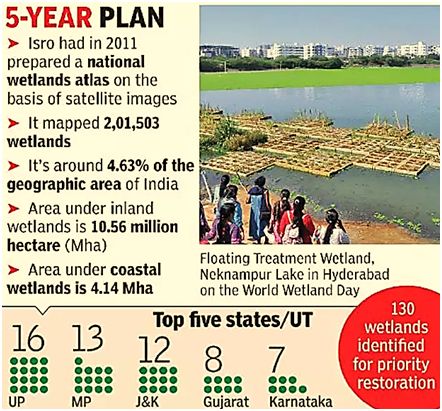India Identifies 130 Wetlands For Priority Restoration
- 07 Sep 2019
- On 7th September, 2019, theGovernment identified 130 wetlands for priority restoration in the next five years.
- The key decision came on the sidelines of the ongoing fourteenth session of the Conference of Parties (CoP) to the United Nations Convention to Combat Desertification (UNCCD) at Greater Noida, Uttar Pradesh.
Priority Actions
- The identified wetlands will be restored under a comprehensive scheme of the National Plan for Conservation of Aquatic Ecosystems (NPCA) for conservation and restoration of wetlands and lakes.
- Concerned states have been asked to submit their respective integrated management plan.
- A new concept of 'Wetland Health Card' would be introduced to monitor the entire ecosystem based on multiple parameters.
- Wetland Mitras (group of self-motivated individuals) will be formed for taking care of the identified wetlands

Wetlands in India
- Indian Space Research Organisation(ISRO) in 2011 came out with a national wetlands atlas on the basis of satellite images, mapping over two lakh wetlands covering around 63% of the total geographic area of India
- The highest number of such identified wetlands are in Uttar Pradesh (16) followed by Madhya Pradesh (13), Jammu & Kashmir (12), Gujarat (8), Karnataka (7) and West Bengal (6).
- India's prominent wetlands include Chilika lake areas (Odisha), Wular lake (J&K), Renuka (Himachal Pradesh), Sambharlake (Rajasthan), DeeporBeel (Assam), East Kolkata wetlands (West Bengal), NalSarovar (Gujarat), Harika (Punjab), RudraSagar (Tripura) and Bhoj wetland (Madhya Pradesh).
Ramsar Convention
Montreux Record
|
Wetlands
- A wetland is a land area that is saturated with water, either permanently or seasonally and it takes on the characteristics of a distinct ecosystem.They include:
- swamps, marshes
- billabongs, lakes, lagoons
- saltmarshes, mudflats
- mangroves, coral reefs
- bogs, fens, and peatlands
- It may support both aquatic and terrestrial species. The prolonged presence of water creates conditions that favor the growth of specially adapted plants (hydrophytes) and promote the development of characteristic wetland (hydric) soils.
Threats to Wetlands
- Drainage for irrigation and agriculture
- As a source of drinking water
- Using the wetlands waters for electricity generation
- Human settlements
- Dredging sediments and exploiting mineral resources
- Intensive harvesting of wetland goods
- Industrial Pollution
- Climate change
- Land fillings
Importance of Wetlands
Ecological Importance
- Carbon Sequestering Systems: Wetlands have the ability to store excess carbon (via photosynthesis) from the atmosphere, one of the primary components of greenhouse gases and a driver of climate change.
- Water Store House:Wetlands work like giant sponges. They store water and then slowly release it, and this helps to deal with dry seasons with little rainfall.
- Water Purification:Wetlands acts as water filter by filtering out sedimentation, decomposing vegetative matter and converting chemicals into useable form.
- Flood Barriers:Wetlands can store the excess water, and slow it down so it distributes more evenly over a floodplain. The roots of trees and other vegetation also help slow the speed of flood waters.
- Ground Water Recharge: Wetlands allow water to soak into the ground, and to replenish the natural ground-water supply.
- Erosion Control: Wetland vegetation binds the soil on stream banks and riparian wetlands, preventing excessive erosion and sedimentation downstream.
- Biological Supermarket: Wetlands can be regarded of as biological supermarkets. As they harbor a variety of species of microbes, plants, insects, amphibians, reptiles, birds, fish and mammals can be part of a wetland ecosystem.
Economic Importance
- Food for Livestock:Wetlands provide good areas for grazing, and the variety of grasses, along with a supply of running water, can be beneficial to farming livestock.
- Other Economical Value:Wetlands yield fuel wood for cooking, thatch for roofing, fibers for textiles and paper making industries and timber for building. Medicines are extracted from their bark, leaves, and fruits, and they also provide tannins and dyes, used extensively in the treatment of leather.
- Recreational Opportunities: Many wetlands contain a diversity of plants, animals and water features that provide beautiful places for sightseeing, hiking, fishing, hunting, boating, bird watching, and photography, providing a better chance for development of tourism industry in any country.
Way Forward
- Wetlands are ecosystems that provide numerous goods and services that have an economic value, not only to the local population living in its periphery but also to communities living outside the wetland area.
- Restoring damaged wetlands should be a high prioritynot only for Indian government but for any government all over the world.
- Recognizing the economic importance of wetlands in addition to their biodiversity, scientific value, climate regulation, potential tourism, socio-cultural and other important wetland values is yet another good reason to reverse global wetland loss.


